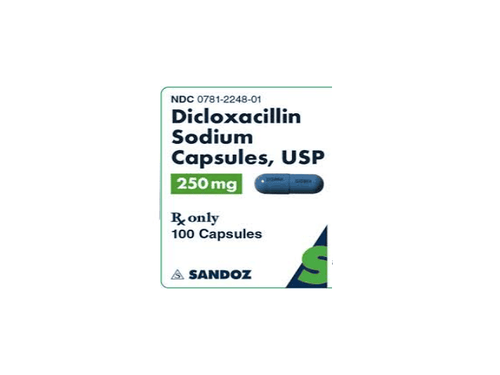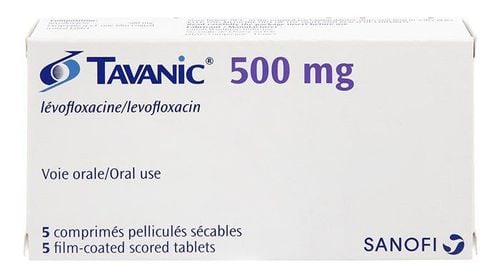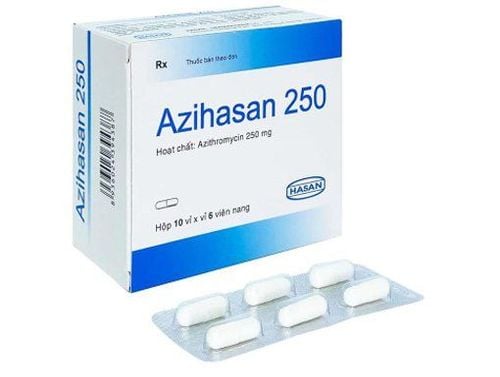This is an automatically translated article.
Quafa-azi is a drug of the antibiotic group, used in cases of bacterial infections. It is a broad-spectrum antibiotic that is active against a wide variety of both gram-negative and gram-positive bacteria. Here is some information about the uses and uses of the drug.
1. Uses of Quafa-AZI
Quafa-azi drug has the main ingredient is Azithromycin (as Azithromycin dihydrate). The content corresponds to each preparation, for the 250mg quafa azi drug containing 250mg Azithromycin and the 500mg quafa azi drug containing 500mg Azithromycin.
Azithromycin is a semi-synthetic antibiotic belonging to the group of macrolides. Structurally, the drug belongs to the same class of drugs, but it differs from erythromycin by the addition of a nitrogen atom substituted with a methyl group to the lactone ring.
Quafa-azi has a strong bactericidal effect by binding to the ribosomes of pathogenic bacteria, thereby preventing their protein synthesis. However, this drug also has cross-resistance with erythromycin, so careful consideration should be given before using azithromycin, because macrolide resistant bacteria in Vietnam have spread quite widely. Azithromycin is active mainly on Gram-positive bacteria such as Streptococcus (Streptococcus), Pneumococcus (Pneumococcal), Staphylococcus aureus (Staphylococcus). Some other strains of bacteria are also very sensitive to the antibiotic azithromycin, such as: Corynebacterium diphtheriae, Propvionibacterium acnes, Clostridium perfringens, Peptostreptococcus.
Azithromycin also works well on some Gram-negative bacteria such as: Haemophilus influenzae, parainfluenzae... In general, azithromycin's effect on Gram-positive bacteria is slightly weaker than erythromycin, but stronger. in some Gram-negative bacteria including Haemophilus.
An advantage of Azithromycin is that it has a long duration of action, so it is usually only needed once a day to avoid drug addiction.
2. Indications and contraindications of Quafa-azi
Quafa-azi drug is indicated in some of the following cases:
Lower respiratory tract infections such as acute bronchitis, pneumonia. Upper respiratory tract infections such as sinusitis, pharyngitis and tonsillitis, otitis media. Skin and soft tissue infections. A sexually transmitted disease in both men and women caused by the bacteria Chlamydia trachomatis or Neisseria gonorrhoeae. Do not use Quafa-Azi in the following cases:
Hypersensitivity to the active ingredient azithromycin or other drugs of the macrolide group. Adjust dose in patients with renal impairment with creatinine clearance less than 40 mL/min and use with caution in patients with hepatic impairment.
3. Dosage and how to use Quafa-Azi
How to use: The drug is in the form of tablets, should be taken with water. Note that because food will reduce the absorption of the drug, azithromycin should not be taken with food. Should be taken 1 hour before meals or 2 hours after meals.
Dosage:
Adults:
Treatment of sexually transmitted diseases such as cervicitis, urethritis caused by Chlamydia trachomatis infection with a single dose of 1g (two quafa-azi 500mg tablets) Other diseases such as bronchitis, pneumonia, pharyngitis, skin and soft tissue infections: The first day take a dose of 500mg (two tablets of Quafa-azi 250mg or one pill of Quafa-azi 500mg) and the next 4 days with one dose. 250mg/day. Children: First day dose of 10 mg/kg body weight followed by 5 mg/kg daily, once daily for 5 days or 10 mg/kg/day x 3 days.
Children under 6 months: There is no information on the efficacy and safety of azithromycin when used in children under 6 months of age; therefore not recommended for use in children in this age group.
4. Side effects when taking the drug Quafa-Azi
Some possible side effects include:
Nausea, abdominal pain, cramping abdominal muscles, vomiting, flatulence, abdominal distension, diarrhea. As with other macrolides and penicillins, sometimes reversible elevations of liver transaminases have been reported with administration. Temporary decrease in neutrophils. Allergic reactions: Rare, but can be life-threatening. Some signs such as hives, itching, difficulty breathing, low blood pressure ... need to take the patient to the nearest facility for timely emergency treatment.
5. Notes when using Quafa-Azi
Some notes when using the drug include:
Before taking the drug, it is necessary to inform the doctor about the history of allergy to the drug or other drugs, the history of using this drug in the past. Because the rate of drug resistance is high now, if there is resistance before, it should not be used. To limit antibiotic resistance, it is necessary to use drugs as prescribed by the doctor. Correct dose and date of use, avoid underdosing or stop taking without your doctor's consent. For pregnant and lactating women: Before taking this medicine, consult your doctor or pharmacist to weigh the benefits and risks of taking this medicine while you are pregnant. Limit use of this drug while breastfeeding, always need to weigh the benefits and risks of breastfeeding. Do not take this medicine with ergot derivatives. Take at least 1 hour before or 2 hours after taking an antacid. Caution should be exercised when co-administering with cyclosporin or digoxin because of possible drug interactions. Quafa-Azi is used in bacterial infections. This is a prescription drug, so it should only be used for bacterial infections and not for viral infections because it is not effective.
Please dial HOTLINE for more information or register for an appointment HERE. Download MyVinmec app to make appointments faster and to manage your bookings easily.













